|
Nanchang
Zoo, China Report
December
2 – 4, 2014
Goals:
The
purpose of the visit was to assess the behavioral problems
of 9-year-old alpha male Tiantian.
Chimpanzees
(Pan troglodytes ?)
Subspecies unknown.
Suggestions:
Subspecies needs to be determined by DNA testing.
The
exact ages of the chimpanzees were unknown; however, they
were all estimated at around seven years old with the
exception of alpha male Tiantian.
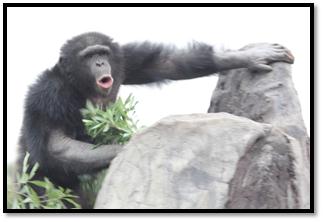 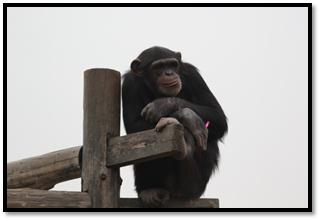
Tiantian
M (9 years old)
Niuniu F (7 years old)
 
Jinjin
M (7 years old) with Nini in the back
Nini F (7 years old)
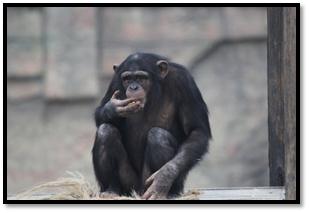 
Qiqi
F (7 years old)
Doudou F (7 years old), with Qiqi in the back
Chimpanzees
had a very nice, spacious exhibit with large night
house areas. There were plenty of climbing structures,
natural soil and grass, and the animals were provided with excellent
diet. Night houses were made of concrete and mesh
without substrate.
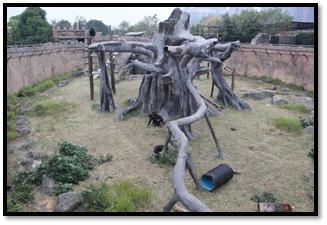 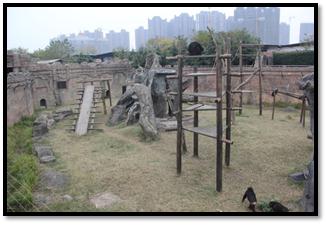
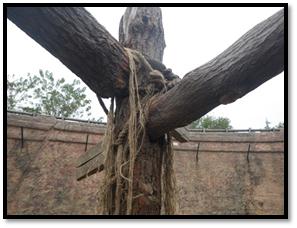 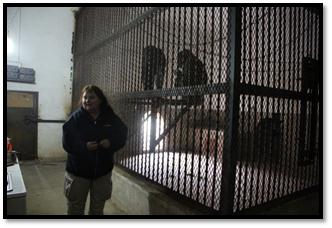
Suggestions:
Frayed ropes need to be replaced and ropes need to be tight
on both ends to avoid chimpanzees injuring themselves
accidentally. One of the chimpanzees was wearing a loose
rope around its neck for several hours.
The
night houses could better utilize three dimensions by adding
large tree trunks and softer fire hose hammocks browse, etc.
to increase space and allow opportunities for exercise,
exploration and manipulation.
Chimpanzees
need to build a nest at night; therefore, substrate such as
browse, hay, straw, etc, need to be provided. Since the zoo
had no loose straw, sleeping straw mats and fresh browse
were given for immediate relief. These kind of materials
need to be provided daily.
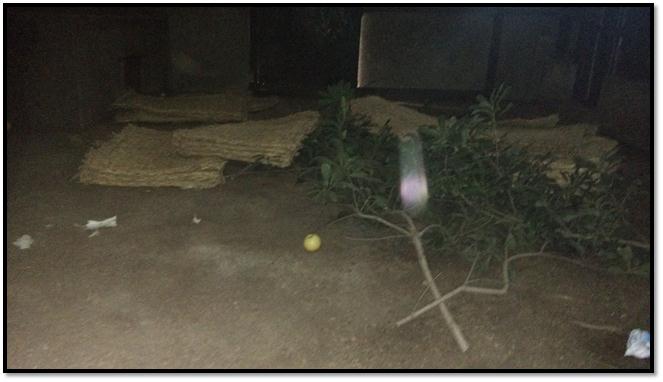
Boomer
ball products are not so easy to come by in China, but
recycled household products (cereal boxes, cardboard boxes,
plastic bottles, barrels, plastic cups, old plush toys,
towels, clothing, tires, etc.) can be easily incorporated as
enrichment/toys.
During
this visit, the majority of time was spent with the
chimpanzees in order to pay full attention to Tiantian’s
problems. It was believed that the alpha male had severe
behavioral problems because he was displaying a lot, threw
rocks at visitors and staff and also was over grooming
himself.
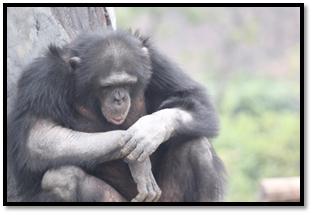 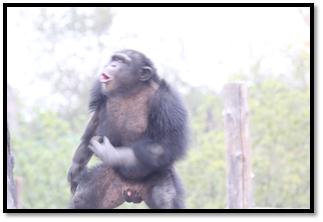
Separation
anxiety and displays
Observations
showed that although he got along well with all other
chimpanzees, he spent most of his time sitting alone,
self-grooming or being upset, displaying and throwing rocks
at visitors and staff. After consulting with staff, we
agreed that he was most likely spending so much time alone
because he was not yet used to being with the group. Due to
his displays, he was separated from the rest of the group
every night for years, therefore (naturally) he displayed
aggressively every day, reassuring his dominance when he was
put together with rest of the group. As expected, his
behavior made the younger animals stay away.
Suggestions:
It needs to be understood that displaying is a natural,
normal behavior for male chimpanzees at any age and males
should not be separated from their group members due to
carrying out these behaviors. “Displays: It is important
to provide opportunities for chimpanzees to move, hit on,
shake, or throw objects in their environment as part of
their species-appropriate displays. Care should be taken
that these objects are adequately fixed, or that they are
not able to cause damage to the enclosure, other
chimpanzees, or to human staff or visiting public.”
Association of Zoos and Aquariums (AZA) Chimpanzee Care
Manual, 2010.
Tiantian
is no longer separated at night and he seems to be
adjusting well. He still spends quite some time apart, but
others approach him, greet him and groom him now that he is
continuously with the group. He will need some time to
adjust. With increased enrichment he could also be kept
busier and relaxed.
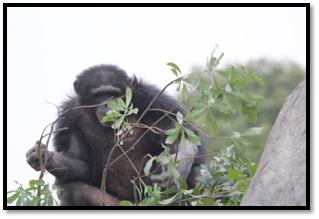
Tiantian
foraging on browse
Challenging
younger male
Tiantian
was also observed being upset about the younger male trying
to breed and groom his females. Jinjin had a better
relationship with the females, since he did not have to be
separated from them.
Suggestions:
Again, this is a normal situation in any chimpanzee group
(having several males competing for females) and their minor
conflicts are acceptable unless the males seriously bite
each other.
Visitor
feeding problems
Visitors
feeding and throwing objects
at the chimpanzees appear
to be ongoing problems. These
issues present challenges in providing nutritionally
correct diet for the chimpanzees, but also contributes
to aggression of the male,
who has begun throwing rocks and larger concrete
pieces at people. At first, it seemed that he was only upset
with visitors, but then the same behaviors were exhibited
when staff members walked by as well. The
specific reasons for this behavior are not entirely clear,
however, throwing objects at visitors is common for
chimpanzees in captivity and could elicit a variety of
responses such as increasing attention given to the animal,
feeding the animal, and/or startling the people. Having
the exhibit lower than the visitor pathways and humans towering over the
chimpanzees could also be a reason for aggression.
Suggestions:
A secondary barrier could be installed preventing humans
from being too close to the chimpanzees and feeding them.
Volunteers and keepers should stand in front of the exhibit
and explain the effects of public feeding on the chimpanzees
Training
Some
of the chimpanzees had difficulties with shifting. The
fundamentals of basic training were taught by keepers
practicing with one another, as well as with the
chimpanzees. Keepers learned correct bridging: teaching the
chimpanzees (especially Tiantian) to quiet down and focus,
target training and closing the door. Shaping plans were
provided.
General
Propositions:
Night
Houses, Off-Exhibit Areas and Correct Substrate Use
Most
of the animals were kept in impressive, large, green
exhibits with plenty of natural furniture and substrates
with the exception of a few large carnivores.
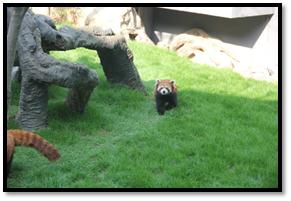 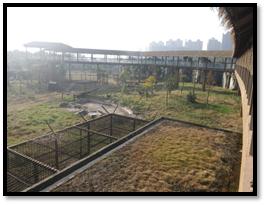
 
 
Suggestions:
For
those few species that are still kept in traditional cages
and on sterile surfaces with
reduced
chance for exploratory behaviours, it is
suggested to create the same environment by breaking up the
concrete or at least covering it with substrate. The use of
appropriate substrate (inside – paper products, hay or
straw, etc.; outside – nonflammable materials such as
grass, sand, soil, mulch, fresh browse, etc.) will make a
significant difference not only in the animals’ mental and
physical health, but also in improvement of the exhibit
aesthetics. In China, paper products are toxic, but
pet-safe, eco-friendly products (bags, wrapping papers,
boxes, burlap bags, etc.) are available online.
Using
substrate will also reduce cleaning time and water
consumption. Soaking, scrubbing and hosing dry waste takes
much longer than spot cleaning due to substrate absorbing
urine and covering feces. Reducing hosing and partially
covering surfaces with substrate will overcome any of these
obstacles and provide animals with a soft surface.
Browse
The
zoo has very impressive edible browse gardens available on
grounds that can provide fresh, leafy branches (browse).

Suggestions:
Browse
should be provided at least every 2 – 3 days, but if
possible, every day. To further increase browse production,
the zoo can plant edible trees, bushes and even crops inside
and outside of exhibits, along visitor pathways and resting
areas that will provide future browsing materials for
growing collection demands. Whether cut by staff or
available by natural damage, fallen vegetation can be used
rather than wasted.
Mixed
Species Exhibits
Mixed
species exhibits can be created in order to free up space
and develop a more esthetic, complex exhibition. This type
of exhibit also resolves certain problems associated with
housing otherwise social species alone until they are paired
with a conspecific. Please review the photos of Phoenix Zoo
mixed exhibits.
 
Lack
of sufficient space and furniture
A
few animals had insufficient space and /or without any
furniture. Sea turtles in general have large territory.

Suggestions:
The turtle requires a minimum space of at least a 120 liter
aquarium and a land area where it can come out of the water
and bask under a heat source.
In
a restaurant, Pythons were kept in glass tables in one of
the restaurants to attract visitors. These
reptiles are very timid, introvert animals that naturally
shy away from people.
Suggestions:
These pythons require a minimum acceptable enclosure
of 2 m in length, 1 m in depth and 1 m in widths. The snakes
also require somewhere a hide box to allow them to withdraw
and take themselves off of view.
 
Smoking
Visitors
and staff were often observed smoking, some of them inside
the night house right next to the animals.
Suggestions:
The
zoo should change its smoking policy by creating designated
smoking areas for visitors with tables, chairs, ashtrays
and garbage cans. All visitors who want to smoke should be
directed to these areas. In addition, keepers should no
longer smoke in front of visitors and absolutely should not
smoke inside the animals' night houses and/or next to the
animals. Keepers must also have designated smoking areas
behind the scenes, out of visitor view. Keepers should only
smoke during their breaks.
Education
The
following PowerPoint presentations were given to all staff:
· Contra Freeloading
at the Phoenix Zoo talks about extending foraging times
by making animals work for their food in ways similar to
their wild counterparts, instead of eating diet in
short periods of time from provided dishes.
· Let Them Be
Elephants addresses the changes the Phoenix Zoo made in
their elephants’ lives by teaching them how to correctly
forage and behave like normal females. It also talks about
basic husbandry, enrichment ideas and health care.
Presentations
are available at htresz@phoenixzoo.org.
I
would like to thank the Nanchang Zoo’s director and staff,
as well as the
Chinese Association of Zoological Gardens (CAZG),
for
their incredible hospitality — making me feel so welcomed.
I
would also like to thank Animals Asia Foundation for funding
and organizing this trip and establishing such a wonderful,
working relationship between the Jane Goodall Institute, the
Phoenix Zoo and the Nanchang Zoo.
|


























